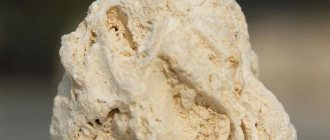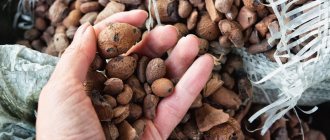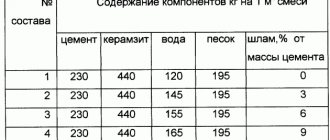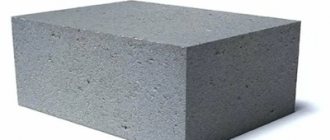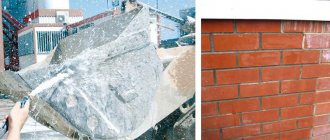Expanded clay is a popular material that is quite in demand in the world of modern construction technologies. To understand where and how best to use it in private housing construction, let’s consider the pros and cons of expanded clay, its classification and labeling, manufacturing methods, transportation rules and methods of application.
Its use depends on the type of expanded clay Source 5144102.ru
Advantages and disadvantages
The undoubted advantage of expanded clay is its low price. The completely budgetary cost of the material is the result of processing cheap raw materials - clay slate or pure clay. Other advantages of expanded clay include the following:
- high strength: thanks to its structure, it can easily withstand significant loads;
- resistance to temperature changes: expanded clay does not collapse and does not lose its properties in a wide temperature range: from -50°C to + 50°C;
- excellent noise insulation qualities allow the material to be used in the construction of sports or musical facilities;
resistance to temperature or chemical influences.
Floor insulation with expanded clay Source hochu-stroitsya.ru
The disadvantages of the substance include dust formation: you should only work with this material in enclosed spaces using a respirator. Another problem is high moisture permeability: the porous structure of expanded clay absorbs water, but is extremely reluctant to part with it. But these disadvantages are offset by the advantages of expanded clay: it is difficult to imagine a replacement for this material in terms of cost, ease of use and range of applications.
Classification and labeling
After processing, expanded clay is sorted. Based on the parameters of the final granules, the material is sorted into the following types:
- gravel: it is round granules without sharp corners, 5 – 40 mm in size, brown or red-brown in color;
- crushed stone: acute-angled fractions, size 5-40 mm. Sharp corners significantly narrow the scope of gravel; crushed stone is used in concrete mixtures;
- sand: granule diameter up to 5 mm. It appears as a by-product of the main production. This sand is used as filler.
Expanded clay is marked according to the grain size of the fractions. Granules are distinguished with sizes of 5-10 mm, 10-20 mm, and so on. An error of 5% is allowed, that is, in a bag with granules of a certain size you can find a small amount of expanded clay of other fractions.
Expanded clay packaging with marking Source plpstatic.ru
The material is also distinguished by bulk density. So, grade 450 will mean that a cubic meter of this material will weigh 450 kg.
Preparing forms
You can make your own molds using a simple 20 mm wooden board. The design is formed on the basis of a pallet and two L-shaped elements, which, when assembled, form sides or 4 standard sides.
The product can be intended for the manufacture of hollow or solid modules:
- forms without voids;
- forms with through voids;
- forms with blind voids.
The product parameters must ensure the production of the required dimensions of the expanded clay concrete block. The inside of the mold is lined with metal. An alternative would be to make the molds entirely from metal. This will ensure that the finished block comes off easily.
Technical properties
Let's take a closer look at the characteristics of expanded clay.
- Strength. This characteristic directly depends on the composition of the feedstock and the size of the fractions. The less porosity of the material, the stronger it is.
- Compaction coefficient - taken into account when storing and selling building materials. This parameter for expanded clay should not exceed 1.15.
- The thermal conductivity of expanded clay is in the range of 0.1-0.18 W/meter (at 0°C). Expanded clay with a thickness of 25 cm retains as much heat as an 18-centimeter thick polystyrene foam crust. The more holes in the granules, the higher the thermal insulation qualities of this insulation.
- Moisture absorption. The proportion of water in its composition can reach 20% if stored improperly. Insulation with a burnt crust allows less moisture to pass through. The more water in expanded clay, the faster it loses its thermal insulation properties.
Dry expanded clay Source userapi.com
- Noise insulation. Expanded clay has excellent soundproofing properties, so it is often used in the construction of interfloor and interior floors.
- Fire safety. Expanded clay is a good insulator. It is non-flammable and chemically inert.
- Heat resistance Expanded clay granules tolerate temperature changes well and can be stored for a long time in frosty open air. The main condition is to keep the material away from water. At high humidity, expanded clay can be destroyed due to freezing of water in its holes.
Among other properties of expanded clay, buyers highlight the low cost of this material and the safety of its use - both for humans and for the environment.
Expanded clay is an environmentally friendly material Source ogorod.ua
See also: Catalog of companies that specialize in home insulation
Product quality control:
After passing the sorting, the expanded clay divided into fractions is sent to the laboratory for final quality control. First of all, the bulk weight of the resulting product is determined, which makes it possible to determine its brand and scope of application. The strength, acid resistance and other characteristics of expanded clay are also tested, guaranteeing customers a high-quality and durable multifunctional material.
In addition, an important role in product quality control is played by the production manager, who monitors the specified parameters of the equipment and is responsible for quickly making decisions in the event of an emergency situation in production.
How is expanded clay made?
Clay is a unique building material, known since ancient times. The word “expanded clay” itself was known to the ancient Greeks, and it is translated as “burnt clay.” For thousands of years, the technology for producing expanded clay has remained virtually unchanged. The raw materials are subjected to sudden temperature changes, which causes pores to appear in the clay, and then it easily crumbles into small granules.
The best raw materials are clays, which contain up to 30% quartz. Sometimes metamorphic rocks with a complex composition are used, which also include clay minerals such as feldspar, micas and various impurities.
To produce expanded clay, raw materials must meet the following requirements:
- fusibility;
- the ability to swell when foaming;
- fast swelling speed.
Expanded clay production: stages of production Source toolbox-site.com
The result of processing the raw material mixture is raw granules of various parameters, which are subsequently dried, fired and cooled. At the final stage of production, expanded clay is sorted according to the parameters and density of each granule. If the granules are too large, they are crushed into small fractions. The finished building material is packaged and stored.
A mini-factory will help you make expanded clay at home. The raw material for homemade expanded clay is expanded clay sand, which is obtained by crushing substandard gravel, and the fuel can be fuel oil, natural gas or coal.
The mini-plant produces expanded clay granules up to 5 mm in size. In this case, any fuel can serve as fuel - from coal to fuel oil. When producing large volumes of material, it is advisable to purchase a crusher that crushes the source material and significantly simplifies production. At home, you can set up the production of granules and produce expanded clay with a volume of up to 30 thousand cubic meters. m per year. You can judge what expanded clay looks like from this photo:
Types of expanded clay Source sazhaemvsadu.ru
Methods for producing expanded clay granules
There are several ways to make expanded clay from raw materials. Each of them is used due to certain circumstances.
Dry method
Dry method
*
The use of rocky rocks, clay or shale, as raw materials leads to the use of this method. The method is to do the following:
- crushing of raw materials on a powerful crushing apparatus, which helps to obtain granules with sizes ranging from 1 to 20 mm;
- firing of processed raw materials in a drum kiln;
- cooling of the composition and subsequent sorting by grain size.
In most cases, production ends here. All that remains is to load the substance into bags and send it for sale. There are no grains formed here, giving them a neat appearance. Therefore, fractions obtained by the dry method can be determined by the uneven edges of each grain.
Wet method
Wet method
The wet method is implemented as follows:
- the raw materials are poured into large containers;
- water is poured into these containers, increasing the humidity of the mixture to 50%;
- using pumps, the mixture is pumped into large pools, from which it passes into the oven;
- In drum ovens, separation into granules by size is carried out, as well as drying of the resulting grains.
The method is very suitable for raw materials that initially have high humidity. By adding water and subsequent drying, it is possible to get rid of excess inclusions and obtain a uniform surface of each granule. It is worth noting that this method requires more energy consumption, but helps to obtain a higher quality product.
Plastic method
Plastic method
*
This expanded clay manufacturing technology is used if the raw material has a moisture content of less than 30%. The clay is passed through hard rollers, which grind the granules to obtain fractions with grain sizes from 5 to 10 mm. Then everything is placed in drying drums and rolling machines, which give each grain the correct oval shape.
After this, the entire mixture is fired in ovens at a temperature of about 1000 degrees. Firing is carried out in drum kilns, the drums of which rotate all the time. The finished granules are transferred to cooling units and dried. And only after that all expanded clay is sorted by granule size.
Powder-plastic method
Powder-plastic method
This method involves preliminary grinding of clay to a powdery state. The powder is mixed with water, thus obtaining a homogeneous mass. Then granules of the correct shape are formed from this mass and the same thing is done as in the previous methods. The fraction is fired and dried. This method helps produce the most accurate mixtures that can be used. However, you have to pay more for high-quality granules, since the method contains additional steps.
The powder-plastic method requires the use of well-processed raw materials, since otherwise the quality of the granules will be significantly reduced.
Storage and transportation
No special conditions are required for storage and transportation of this material. Expanded clay is stored in packaged form, in warehouses or outdoors, under a canopy. This prevents damage and contamination. Expanded clay is protected from water, since when moisture gets into the pores of the material, its strength noticeably decreases.
Transportation of expanded clay is consistent with GOST 25880; it can be transported packaged or in bulk. For transportation, ships (barges), rail and road transport are used. Loading is carried out in clean containers, without the remains of previously transported goods. Loading and unloading is carried out with minimal mechanical impact to prevent the destruction of granules. Ingress of water, dirt, and loss of cargo are excluded.
Storage and transportation of expanded clay Source keramzitspb.ru
Material that is not currently used in construction should be covered with a waterproof coating and sides constructed. It is advisable to lay slate, roofing felt, and roofing iron underneath.
Expanded clay in construction
The properties of expanded clay make it an indispensable material for insulating exterior and interior walls and floors. Let's look at just some of the ways to use expanded clay in construction.
Floor screed
The use of expanded clay when screeding a floor can significantly reduce the load on supporting structures. The work is completed in two days, resulting in a perfectly flat floor with high noise-absorbing properties.
The work process is as follows:
- the floor and bottom of the walls (5-10 cm) are cleaned and covered with polyethylene;
- A layer of expanded clay is poured onto the film. The larger the size of the granules, the lower the density of the layer and the less pressure on the supporting structures;
- expanded clay is filled with a thin layer of liquid cement;
- After complete drying (48 hours), proceed to screed the floor.
Expanded clay screed Source pol-inform.ru
Thermal insulation work
Insulation with expanded clay is carried out using a similar technology. If a wooden floor is being insulated, then there is no need to fill the expanded clay layer with cement: the floor is simply covered with boards on top. An additional advantage of this method: rodents and harmful insects do not grow in the expanded clay layer.
Foundation insulation
Foundation insulation can be carried out both inside and outside the building. During external work on insulating the foundation, expanded clay gravel is used to fill the empty space under the blind area from the yard. When insulating the inside of a building, work is carried out under the ceiling of the first floor.
Important! It should be remembered that the main enemy of expanded clay is moisture, therefore, with any insulation, the expanded clay layer should be protected with good waterproofing.
Wall insulation
Insulation with expanded clay is most often done using the three-layer masonry method. To do this, you will need expanded clay concrete blocks, which are made from a mixture of expanded clay, sand, cement and water. The insulation technology comes down to the following:
- the supporting layer is laid out from expanded clay concrete blocks;
- to lay the base layer, make a solution of cement laitance and expanded clay (capsimet);
- The protective layer consists of facing materials that protect the base layer from moisture.
Equipment preparation
To produce the material, the master will need a concrete mixer and a vibrating machine.
Manual vibration machines
The small-sized device is optimal for carrying out work in non-professional conditions.
Main characteristics:
- the vibrator is fixed on the body and produces moderate vibrations, which ensures uniform distribution of the working mass over the shape;
- The product is equipped with stationary and removable void formers. In the first case, solid and hollow modules can be produced;
- depending on the manufacturer and additional options, the cost of the vibrator reaches 10 thousand rubles.
The use of special equipment will ensure high quality of the finished block, but may be expensive for private construction
Mechanized mobile machines
Main characteristics:
- the equipment is equipped with a supporting body and a lever drive for automatic removal of the mold from the body;
- the machine is equipped with wheels that allow easy movement around the site;
- depending on your needs, you can choose a model with various add-ons, for example, a compacting press;
- the vibrator is fixed on the device and sends an impulse to the form;
- the device can be equipped with 4 matrices, which speeds up the production process;
- the cost reaches 16 thousand rubles
Vibrating table
Main characteristics:
- the base of the device is equipped with a built-in vibrator; a metal tray up to 3 mm thick is placed here;
- Forms are placed on a pallet and compacted by vibrations;
- then the pallet is taken to a ventilated, dry place where the material finally dries;
- all manipulations are carried out manually;
- You can prepare up to 6 forms at a time, which are conveniently transported on a pallet to the drying place;
- the lower placement of vibrators allows you to obtain a complete and optimal distribution of vibrations throughout the table;
- the cost of equipment fluctuates around 20 tr;
- The vibrating table is not mobile, large in size and requires a lot of manual labor.
Vibropress
Equipment of this class is used in large factories and enterprises. At all stages of block production, manual labor is practically eliminated. The device is characterized by high performance and allows you to obtain excellent quality modules.
A concrete mixer with a volume of at least 130 liters is used to mix the mixture.
Use of expanded clay in other fields of activity
Construction is far from the only area of application for expanded clay granules. This material is often used to cover garden paths in summer cottages. Expanded clay is laid as the first layer that comes into contact with the ground. The standard installation diagram can be seen in the figure:
Garden paths on expanded clay Source samdizajner.ru
Expanded clay paths remain dry even after heavy rainfall. Dirt does not accumulate on them, they are easy to clean, and if necessary, such a path can be easily moved to a new place.
Expanded clay is often used for mulching the soil, and in this capacity it is used both in gardening and in growing indoor plants.
The use of expanded clay in landscape design is also known. Bright granules favorably set off the greenery of the park. Expanded clay crushed stone is used to fill voids in alpine slides, level the surface of flower beds, and fill the soil for less water consumption. And if someone thinks that the brown color is quite boring, do not be upset: currently, expanded clay is sold in stores in various colors, and it will not be difficult to choose the right shade.
Decorating with expanded clay Source aviarydecor.com

